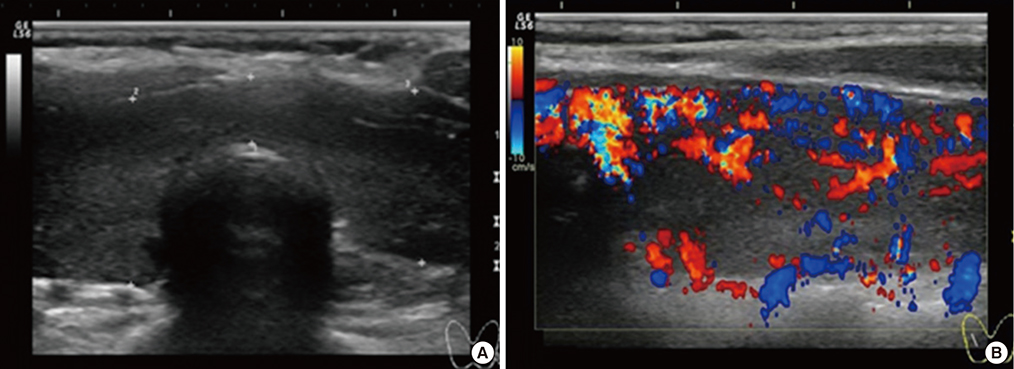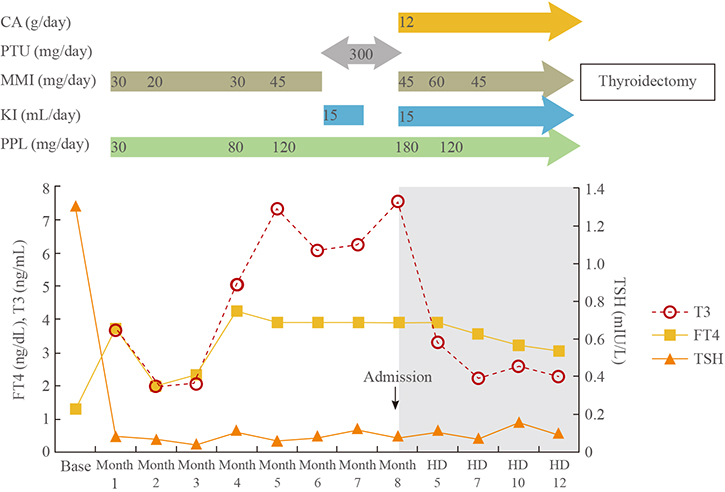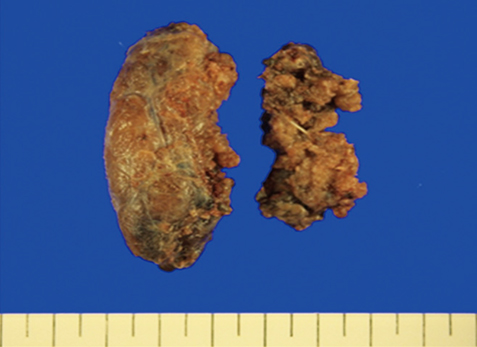Endocrinol Metab.
2015 Dec;30(4):620-625. 10.3803/EnM.2015.30.4.620.
Refractory Graves' Disease Successfully Cured by Adjunctive Cholestyramine and Subsequent Total Thyroidectomy
- Affiliations
-
- 1Department of Internal Medicine, Seoul St. Mary's Hospital, College of Medicine, The Catholic University of Korea, Seoul, Korea. ldj6026@catholic.ac.kr
- 2Department of Surgery, Seoul St. Mary's Hospital, College of Medicine, The Catholic University of Korea, Seoul, Korea.
- KMID: 2169675
- DOI: http://doi.org/10.3803/EnM.2015.30.4.620
Abstract
- The three major forms of treatment for Graves thyrotoxicosis are antithyroid drugs, radioactive iodine therapy and thyroidectomy. Surgery is the definitive treatment for Graves thyrotoxicosis that is generally recommended when other treatments have failed or are contraindicated. Generally, thyrotoxic patients should be euthyroid before surgery to minimize potential complications which usually requires preoperative management with thionamides or inorganic iodine. But several cases of refractory Graves' disease have shown resistance to conventional treatment. Here we report a 40-year-old female patient with Graves' disease who complained of thyrotoxic symptoms for 7 months. Her thyroid function test and thyroid autoantibody profiles were consistent with Graves' disease. One kind of thionamides and beta-blocker were started to control her disease. However, she was resistant to nearly all conventional medical therapies, including beta-blockers, inorganic iodine, and two thionamides. She experienced hepatotoxicity from the thionamides. What was worse is her past history of serious allergic reaction to corticosteroids, which are often used to help control symptoms. A 2-week regimen of high-dose cholestyramine improved her uncontrolled thyrotoxicosis and subsequent thyroidectomy was successfully performed. In conclusion, cholestyramine could be administered as an effective and safe adjunctive agent for preoperative preparation in patients with severe hyperthyroid Graves's disease that is resistant to conventional therapies.
MeSH Terms
Figure
Cited by 1 articles
-
A Case of Methimazole-Resistant Severe Graves' Disease: Dramatic Response to Cholestyramine
Seung Byung Chae, Eun Sook Kim, Yun Im Lee, Bo Ram Min
Int J Thyroidol. 2016;9(2):190-194. doi: 10.11106/ijt.2016.9.2.190.
Reference
-
1. Moon JH, Yi KH. The diagnosis and management of hyperthyroidism in Korea: consensus report of the korean thyroid association. Endocrinol Metab (Seoul). 2013; 28:275–279.2. Weetman AP. Graves' disease. N Engl J Med. 2000; 343:1236–1248.3. Langley RW, Burch HB. Perioperative management of the thyrotoxic patient. Endocrinol Metab Clin North Am. 2003; 32:519–534.4. Li H, Okuda J, Akamizu T, Mori T. A hyperthyroid patient with Graves' disease who was strongly resistant to methimazole: investigation on possible mechanisms of the resistance. Endocr J. 1995; 42:697–704.5. Sebastian-Ochoa A, Quesada-Charneco M, Fernandez-Garcia D, Reyes-Garcia R, Rozas-Moreno P, Escobar-Jimenez F. Dramatic response to cholestyramine in a patient with Graves' disease resistant to conventional therapy. Thyroid. 2008; 18:1115–1117.6. Saleem T, Sheikh A, Masood Q. Resistant thyrotoxicosis in a patient with Graves' disease: a case report. J Thyroid Res. 2011; 2011:649084.7. Solomon BL, Wartofsky L, Burman KD. Adjunctive cholestyramine therapy for thyrotoxicosis. Clin Endocrinol (Oxf). 1993; 38:39–43.8. Mercado M, Mendoza-Zubieta V, Bautista-Osorio R, Espinoza-de los. Treatment of hyperthyroidism with a combination of methimazole and cholestyramine. J Clin Endocrinol Metab. 1996; 81:3191–3193.9. Tsai WC, Pei D, Wang TF, Wu DA, Li JC, Wei CL, et al. The effect of combination therapy with propylthiouracil and cholestyramine in the treatment of Graves' hyperthyroidism. Clin Endocrinol (Oxf). 2005; 62:521–524.10. Kaykhaei MA, Shams M, Sadegholvad A, Dabbaghmanesh MH, Omrani GR. Low doses of cholestyramine in the treatment of hyperthyroidism. Endocrine. 2008; 34:52–55.11. Hoogenberg K, Beentjes JA, Piers DA. Lithium as an adjunct to radioactive iodine in treatment-resistant Graves thyrotoxicosis. Ann Intern Med. 1998; 129:670.12. Pandey CK, Raza M, Dhiraaj S, Agarwal A, Singh PK. Rapid preparation of severe uncontrolled thyrotoxicosis due to Graves' disease with iopanoic acid: a case report. Can J Anaesth. 2004; 51:38–40.13. Ozbey N, Kalayoglu-Besisik S, Gul N, Bozbora A, Sencer E, Molvalilar S. Therapeutic plasmapheresis in patients with severe hyperthyroidism in whom antithyroid drugs are contraindicated. Int J Clin Pract. 2004; 58:554–558.14. Dahlberg PA, Karlsson FA, Lindstrom B, Wide L. Studies of thyroid hormone and methimazole levels in patients with Graves' disease on a standardized anti-thyroid drug regimen. Clin Endocrinol (Oxf). 1981; 14:555–562.15. Butani L. Corticosteroid-induced hypersensitivity reactions. Ann Allergy Asthma Immunol. 2002; 89:439–445.16. Lin D, Suwantarat N, Bornemann M. Cholestyramine for thyrotoxicosis? J Fam Pract. 2013; 62:E1–E2.17. Northcutt RC, Stiel JN, Hollifield JW, Stant EG Jr. The influence of cholestyramine on thyroxine absorption. JAMA. 1969; 208:1857–1861.
- Full Text Links
- Actions
-
Cited
- CITED
-
- Close
- Share
- Similar articles
-
- A Case of Methimazole-Resistant Severe Graves' Disease: Dramatic Response to Cholestyramine
- A Case of Graves' Disease associated with Myasthenia Gravis treated by Bilateral Subtotal Thyroidectomy and Total Thymectomy
- Graves' Disease: Can It Be Cured?
- Cholestyramine Use for Rapid Reversion to Euthyroid States in Patients with Thyrotoxicosis
- Total Thyroidectomy in Graves' Disease




